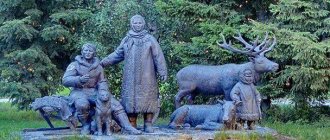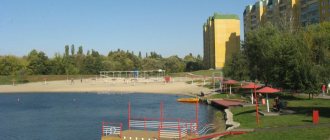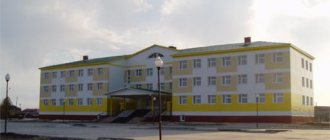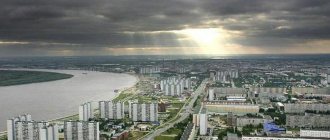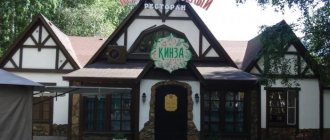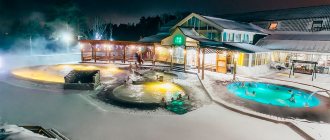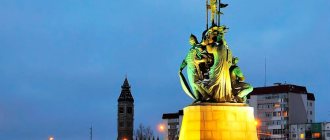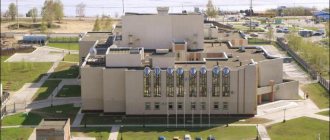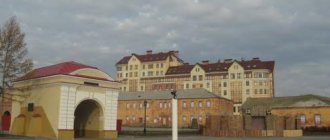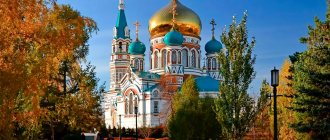Great guide to the Khanty-Mansiysk Autonomous Okrug - Ugra
Endless taiga, lakes, wide rivers, birch trees of bizarre shapes growing in swamps, white nights in summer and an amazing low sky. The Khanty-Mansi Autonomous Okrug - Ugra is a region of contrasts, where megacities coexist with the ancestral lands of the Khanty and Mansi, who lead their lives according to centuries-old traditions. The Tutu travel service, together with the Ugra Development Fund, has prepared a large guide to the region: where to live, what to eat and how to have fun in the region.
What is the name of the main city of Khmao?
Khanty-Mansiysk is the administrative center of the Khanty-Mansiysk Autonomous Okrug - Ugra, its territory is 337.76 thousand square meters. km.
Interesting materials:
What do vitamins A and E contain? What is the difference between CD and DVD? What is the essence of the Dutch auction? What is the essence of the accounting profession? What is the essence of separation of powers and checks and balances? What are the harms of creatine? What should you wear to discharge your child from the maternity hospital in November? What is genius? What is brightness expressed in? What is normality?
How to get to Ugra
Ugra is a large region, the distance between cities is impressive, so the first thing you should do is decide where exactly you need to go.
Khanty-Mansiysk district receives flights from Rossiya Airlines, Red Wings, RusLine and others. You can get directly to the city from Moscow, St. Petersburg, Yekaterinburg, Tyumen, Novosibirsk, Ufa and Chelyabinsk, and during the holidays - from Krasnodar, Anapa, Sochi and Simferopol. Tickets become more expensive during the holiday season. In the fall of 2022, a flight from Moscow (one way without luggage) costs from 4,300 ₽, from St. Petersburg - from 8,000 ₽. Travel time from both capitals is 3 hours.
A regional network of air routes is developed in Ugra. On Utair airliners you can get to any part of the district in an hour and a half. From Khanty-Mansiysk you can fly to Beloyarsky (from 2641 ₽), Berezovo (from 3125 ₽), Kogalym (from 2641 ₽), Nizhnevartovsk (from 2641 ₽), Nyagan (from 2158 ₽), Sovetsky (from 2158 ₽) and Surgut (from 2158 ₽). All major cities in the district are connected by direct flights, which allows you to build your own route around the region.
Surgut Airport is a large regional hub. All major airlines operate here, Rossiya, Pobeda, Utair, Ural Airlines, S7 Airlines and others. Surgut is connected by direct flights to Moscow, St. Petersburg, Yekaterinburg, Kazan, Novosibirsk, Tyumen, Krasnodar, Omsk, Barnaul, Belgorod, Bugulma, Volgograd, Grozny, Krasnoyarsk, Makhachkala, Mineralnye Vody, Nizhnekamsk, Perm, Rostov, Samara, Tomsk, Ufa, Chelyabinsk. During the holiday season, destinations are open to Gelendzhik, Anapa, Simferopol, and Sochi.
In the fall of 2022, a ticket from Moscow to Surgut costs from 2,000 ₽. Travel time will be 3.5 hours. The flight from St. Petersburg takes 3 hours 20 minutes, ticket price starts from 6200 ₽.
Utair airline connects Surgut with other cities of the district: Beloyarsky (from 3125 ₽) and Khanty-Mansiysk (from 2158 ₽). The flight in both directions is a little over an hour. Ural Airlines flies to Nizhnevartovsk - in 45 minutes and 2175 ₽.
There are also trains to Surgut. It takes two days to travel from Moscow, a ticket costs from 5,200 ₽ for a reserved seat and from 7,000 ₽ for a compartment.
to Nizhnevartovsk from Moscow, St. Petersburg, Yekaterinburg, Tyumen, Voronezh, Ufa, Astrakhan, Bugulma, Omsk, Novosibirsk, Rostov-on-Don, Samara, Tomsk, and during the holiday season - from Krasnodar, Sochi, Simferopol, Mineralnye Vody.
In the fall of 2022, a ticket from Moscow costs from 8,400 ₽, the flight takes 3.5 hours. A ticket from St. Petersburg costs from 7,000 ₽.
You can get from Moscow to Nizhnevartovsk by train in 52 hours. A reserved seat ticket will cost on average 6,000-8,000 rubles.
Utair airline operates at Kogalym The city receives flights from Moscow and Khanty-Mansiysk. A ticket for a flight from Moscow costs from 6800 ₽ to 9000 ₽. Travel time is 3 hours 20 minutes. It takes a little more than two days to travel by train from Moscow. The price of a ticket for a reserved seat and a compartment is from 5,500 ₽. You can get to Kogalym by car from Surgut in three hours, combining the trip with a visit to the village of Russkinskaya in the Surgut region.
Khanty-Mansiysk
Khanty-Mansiysk is a compact city with a population of more than 100 thousand people. However, world-class political, economic, sporting and cultural events take place here. For example, all-Russian and international competitions in biathlon or chess. Once a year, the city hosts the Spirit of Fire festival of cinematic debuts; the next one will take place at the end of February 2022. You are unlikely to be able to explore the city in one day.
Housing
On days of sporting events, world sports stars stay at the 3* Olimpiyskaya Hotel on Engelsa, 45 (RUB 3,600/day). The hotel is suitable for people with disabilities. You can dine here at the Olympus restaurant.
Another popular 3* hotel (from 3520 ₽/day) with free parking.
On the banks of the Irtysh you can stay in the boutique hotel “Molly O'Brien” 4* (from 5500 ₽/day). For a fee you can relax in the sauna or have a barbecue.
Surrounded by coniferous forest, next to the biathlon center. A. V. Filipenko, the three-star hotel complex “Misne” is located. In October 2022, a night with breakfast will cost 5,050 RUB when booking on Booking. Guests are offered ethnographic programs with tasting dishes of traditional Khanty cuisine, walks in the Samarovsky Chugas natural park and gastronomic souvenirs.
On Lenina, 54 there is a three-star business hotel “Tarey” (5500 ₽/day). Guests have access to parking, a sauna and a fitness room.
What to see
The visiting card of Khanty-Mansiysk is the “Archaeopark” with sculptures of ancient animals. But we suggest starting your walk from the rotunda fountain in the central square and walking through Victory Park to the State Museum of Nature and Man (Mira, 11). Admission for visitors under 18 years of age is free, an adult ticket costs 150–250 rubles (depending on the number of exhibitions), a tour for three people costs 450–750 rubles, an additional payment for each additional guest costs 250 rubles.
On Mira, 22 there is a cultural and theater center. Try to get into the Organ Hall: a unique German organ is installed there; its keys are inlaid with the bone of a baby mammoth that has lain in permafrost for more than 500 thousand years. Falling in love with organ music costs from 400 to 600 rubles.
Next, through Boris Losev Park we go to the Museum of Geology, Oil and Gas (Chekhova, 9). This is the only state “oil” museum in the country. The collection includes 37 thousand items from the history of geological exploration, the development of the oil and gas industry, as well as samples of minerals, rocks and oil. Ticket for children over 7 years old and students - 100 ₽, for adults - 170 ₽; Every first Thursday of the month, admission to the museum is free. The excursion for adults will cost 250 rubles, for schoolchildren and students - 100 rubles, for preschoolers - 30 rubles.
By the way, in the park named after Boris Losev there is a 16-meter fountain “Ob and Irtysh” with animal sculptures, which turns into a cascade of “Fish” fountains. A great place for evening walks: the illuminated fountain shows a map of the starry sky.
Here in the center, on Loparev Street, it is worth visiting the House-Museum of the artist Vladimir Igoshev and the Yugra Chess Academy - they are located nearby in houses No. 6 and No. 7. The last building is completely covered in metal and shimmers beautifully. And the Igoshev house-museum deserves special attention. Here, in addition to the works of the artist himself, you will see originals by Repin, Aivazovsky, Surikov and Levitan. The chamber fireplace room hosts musical evenings and literary meetings, and master classes on weekends. The excursion costs from 250 to 1000 rubles. A theatrical program awaits you for the maximum price.
A few minutes drive from the city center, on Obezdnaya, 29, is the Archeopark of Khanty-Mansiysk . At the very foot of the Samarovsky outlier there is the archeological monument “Samarov Town” and a sculpture park: there is a family of mammoths, a bison, a pair of rhinoceroses, a cave bear, a pack of wolves and primitive people. Admission is free, content for Instagram is provided.
Another interesting place is the open-air ethnographic museum “Torum Maa” (Sobyanina, 1). From the Mansi language the name is translated as “Sacred Land”. Here you can get a complete picture of the life and everyday life of the small peoples of the North. The founders of the museum - representatives of the Khanty-Mansi intelligentsia Yuvan Shestalov and Eremey Aipin - donated original buildings from their ancestral lands to the museum. Entrance to the exhibition costs from 50 to 200 rubles, excursions - from 300 to 500 rubles; photo in national clothes - 100 ₽; visit to the Kasne Maa rope park - from 250 ₽; master class on traditional crafts - 1100 ₽ (you must register in advance).
World biathlon stars Ole Einar Bjoerndalen, Daria Domracheva, Magdalena Neuner and others performed at the A. V. Filipenko Winter Sports Center In the summer you can skate along the track on your own rollerblades (1.5 hours of skating - 500 ₽ for children and 900 ₽ for adults), in winter - on skis (renting the track for the whole day - 400 ₽).
At the Ice Palace you can relax in the water park (from 120 to 300 ₽ depending on age and time of visit), go to the sauna or Turkish bath (1000 ₽ for six), go skating (from 150 to 480 ₽, skate rental - 120 ₽ ).
For lovers of snowboarding and alpine skiing, there is the Khvoyny Urman complex (Ledovaya, 14). Sightseeing ride on the cable car - 100 ₽, hour of use - 300 ₽, ice skating - 100-200 ₽, skate rental - 50-100 ₽, half an hour of table tennis - 200 ₽. Here you can rent a gazebo with a barbecue - from 1500 to 5000 rubles, depending on comfort.
The highest point of the city, the peak of which is visible from any place, is a memorial sign “To the Discoverers of the Ugra Land” (Pervootkryvatel, 1). The triangular 60-meter pyramid resembles the Khanty tent, a Cossack observation tower, and an oil derrick. There is an observation deck next to the building.
Another place of power is the floating chapel-lighthouse of St. Nicholas the Wonderworker at the confluence of the Ob and Irtysh. Locals say that this is a sacred place for the Khanty and Mansi peoples. You can get here in the warm season by excursion boat, flights depart from the River Station (Boris Shcherbina, 3). Trips are organized by Ermak Tour on the motor ship Moscow-145, price - 1000 ₽ per person.
Source
General information about the Khanty-Mansiysk Autonomous Okrug
Distinctive features. Mecca for those who love black money. A place from which more than 50% of all Russian oil is pumped out annually, most of which is sold to the West, making the oligarchs richer every day. The Khanty-Mansiysk Autonomous Okrug - Yugra ranks first in Russia in oil production and second in gas production. The main large cities are concentrated around oil fields. Their population is constantly growing - many believe that this is a kind of “American Dream”. True, in the middle of the taiga expanses of Siberia.
Black gold. It paints many hearts exactly this color
Despite the abundance of industrial cities, the Khanty-Mansi Autonomous Okrug - Ugra still has a small number of indigenous inhabitants: Khanty, Mansi, Nenets. This is a people with a rich history, centuries-old traditions, and a unique culture. Their main occupations are hunting, fishing, fur trading, and animal husbandry.
Mansi and the little ones Mansyata. Photo by dreamer (https://fotki.yandex.ru/users/valeriy-dreamer/)
Tourism of all types is quite seriously developed in the Khanty-Mansiysk Autonomous Okrug. This is not surprising, because the hills and elevations offer endless opportunities for alpine skiing, snowboarding, and kiting. And lovers of sports and ecological tourism will be able to enjoy exploring numerous natural parks and reserves. And even visit two state reserves.
By the way, about the environment. But here everything is bad. Emissions from the combustion of oil gas, petroleum products, pollution from exhaust gases in large cities - all this causes irreparable harm to nature and human health.
This is how they set the sky on fire
Geographical location. There are thousands of rivers and lakes on the territory of the Khanty-Mansiysk Autonomous Okrug - Ugra. The main rivers are the Ob and Irtysh. A third of the district is swamps, and more than 50% of the entire territory is taiga forests. The district's topography consists of plains, foothills, and mountains, the height of which reaches almost 2000 meters.
In the south, the Khanty-Mansiysk Autonomous Okrug - Ugra borders on the Uvat and Tobolsk districts of the Tyumen region, in the southeast and east - on the Tomsk region and the Krasnoyarsk Territory, in the southwest on the Sverdlovsk region, in the northwest - on the Komi Republic, on in the north with the Yamalo-Nenets Autonomous Okrug.
The population of the district is 1,584,063 people, and in terms of urbanization the Khanty-Mansiysk Autonomous Okrug ranks fifth in Russia. The birth rate is one of the highest in Russia, and the death rate is one of the lowest. This is due to both the high number of women of active reproductive age, the increased quality and standard of living, and a well-developed healthcare system.
The main population is Russians, more than 68% of them in the Khanty-Mansiysk Autonomous Okrug - Yurga. In addition to them, Tatars, Ukrainians, and Bashkirs live - 16%. It is worth noting that the indigenous inhabitants of this taiga stronghold, the Khanty and Mansi, are only a modest 2% of the total population of the district.
Crime. The crime rate is 23rd in Russia. According to the Head of the District Ministry of Internal Affairs, the crime rate is continuously decreasing. The police successfully fight against all sorts of violations of the law - from the organization of illegal dens to murders, robberies and corruption in government. At the same time, a fairly high level of theft and drug addiction remain problems.
The unemployment rate is 5.3% and compared to last year it decreased by 1%. In terms of wages - well, here in large cities Stalin’s wish “Life has become better, life has become more fun” has come true. The salary of a simple teacher, for example, can be more than 45,000 rubles per month. The average salary in the district is more than 50,000 rubles. Which, of course, leads to an endless stream of migrants from the south.
Property value. Living in cities of great opportunity is not a cheap pleasure. A normal 1-room apartment of 40 meters in Surgut will cost you at least 3 million rubles, in Nizhnevartovsk - 2.7 million rubles, and in Nefteyugansk more than 3.3 million rubles. Well, renting an apartment here is not cheap - one-room apartments, for example, start at 20,000 rubles per month.
Climate. Winters are snowy and long (from October to April), temperatures can reach −60 °C, but on average it stays at −20 °C. And summer will not spoil heat-loving people - the average temperature is only +16.5 °C. 400-620 mm of precipitation falls per year, most of it falls in the warm season.
Eternal cold or the last abode of mammoths
Khanty-Mansiysk
| Population: ↗ 98,485 people. | City area: 337.76 km 2 |
| Time zone: UTC+5 | Telephone code: +7 (3467) |
| Postal code: 628000 | Housing cost per m2: 25,600 rubles. |
| Dec. | Jan. | Feb. | Mar. | Apr. | May. | Jun. | Jul. | Aug. | Sep. | Oct. | But I. |
| -16.5° | -18.9° | -16.8° | -8.3° | -1.4° | +7.5° | +15.5° | +18.4° | +14.4° | +7.7° | +0.2° | -10.8° |
Khanty-Mansiysk through the eyes of a resident. About climate, ecology, areas, real estate prices and work in the city. Pros and cons of living in Khanty-Mansiysk. Reviews from residents and those who moved to the city.
General information and a little history of Khanty-Mansiysk
Khanty-Mansiysk, a small and cozy capital of a huge oil region, is located on the right bank of the great Irtysh, only 20 km from the place where it merges with the equally mighty Ob.
Unlike many Ugra cities, Khanty-Mansiysk, although it has a new name, stands in the old “acquired” and “prayed” place. Once upon a time there was a town of the Ostyak prince Samara. In 1637, Tsar Mikhail Fedorovich sent a family of coachmen to settle here to organize the Yamsk race between Tobolsk and Berezovo, and the Samarov town became Samarovsky Yam. Over time, the pier became increasingly important - Samarovo became a large village that played a significant trading role due to its position in the middle of the road to Berezovo and Surgut from Tyumen and Tobolsk. Already at the beginning of the 19th century, a stone Church of the Intercession of the Blessed Virgin Mary was built here.
After the organization of the Ostyako-Vogul national district in 1931, it was decided to rebuild its capital - Ostyako-Vogulsk, 5 km from the village of Samarovo, which became part of the new city. The future Khanty-Mansiysk was built by all sorts of unreliable “elements” exiled here for “reforging”. To this day, the indigenous Khanty-Mansi people still call the area of Roznina Street Perekovka. Ostyako-Vogulsk received its current name in 1940, and became a city in 1950.
On the left is the Tax Inspectorate building, on the right is the Museum of Oil and Gas Geology. The intersection of Dzerzhinsky and Chekhov streets
Map
| Khanty-Mansiysk: maps |
Khanty-Mansiysk: photo from space (Google Maps) Khanty-Mansiysk: photo from space (Microsoft Virtual Earth)
| Khanty-Mansiysk. Nearest cities. Distances in km. on the map (in brackets along roads) + direction. Using the hyperlink in the distance , you can get the route (information courtesy of the AutoTransInfo website) | |||
| 1 | Poikovsky | 155 (168) | IN |
| 2 | Salym | 168 (353) | SE |
| 3 | Lyantor | 181 (334) | IN |
| 4 | Nefteyugansk | 193 (231) | IN |
| 5 | Uvat (Tyumen region) | 207 (574) | YU |
| 6 | Pyt-Yakh | 208 (248) | IN |
| 7 | Nizhnesortymsky | 215 () | NE |
| 8 | Oktyabrskoe | 225 () | NW |
| 9 | Solar | 225 () | IN |
| 10 | Barsovo | 226 (285) | IN |
| 11 | Nyagan | 228 (295) | NW |
| 12 | Bely Yar | 229 (283) | IN |
| 13 | Turtas (Tyumen region) | 230 (567) | YU |
| 14 | Mezhdurechensky | 233 (563) | SW |
a brief description of
Located in Western Siberia, on the Irtysh (port), 15 km from its confluence with the Ob, 264 km west of the railway. Nefteyugansk station, 1076 km northeast of Tyumen, 2759 km northeast of Moscow.
The climate is continental with long, harsh winters. Average temperatures in January are from -18 to -23, in July +16 +19. Precipitation is about 500 mm per year.
Biathlon center.
Territory (sq. km): 338
Information about the city of Khanty-Mansiysk on the Russian Wikipedia site
Historical sketch
In 1931, 5 km from the village of Samarovo (founded in 1637 as a settlement of coachmen, Samarovsky Yam; named after the Ostyak prince Samara), the village of Ostyako-Vogulsk was founded - the administrative center of the Ostyak-Vogulsky national district. It was part of the Ural region, and since 1934 - the Omsk region.
The workers' settlement of Ostyako-Vogulsk since 1936. Since 1940 it has been called Khanty-Mansiysk (Ostyaks began to be called Khanty, Vogul Mansi), the center of the Khanty-Mansiysk National Okrug. Since 1944, part of the Tyumen region. A city since January 27, 1950, it included the village of Samarovo (5.9 thousand inhabitants, 1939).
Since 1977 - the center of the Khanty-Mansiysk Autonomous Okrug.
Municipal indicators
| Index | 1990 | 1999 | 2001 | 2003 | 2005 |
| Demography | |||||
| Number of births, per 1000 population | 15.3 | 14.9 | 17.8 | 16.2 | 17.6 |
| Number of deaths, per 1000 population | 7.7 | 11.8 | 12.9 | 10.5 | 9.1 |
| Natural increase (decrease), per 1000 population | 7.6 | 3.1 | 4.9 | 5.7 | 8.5 |
| Standard of living of the population and social sphere | |||||
| Average monthly nominal accrued wages, rub. | 0.472 | 4339 | 10474 | 15896 | 22370.1 |
| Average housing area per inhabitant (at the end of the year), sq.m. | 14.5 | 17.8 | 18 | 15 | 16.8 |
| Number of preschool institutions, pcs. | 25 | 20 | 20 | 20 | 19 |
| Number of children in preschool institutions, thousand people | 3.2 | 2.1 | 2.2 | 2.3 | 2.3 |
| Enrollment of children in preschool educational institutions (at the end of the year), as a percentage of the number of children of the corresponding age, % | 62.2 | 57.7 | |||
| Number of daytime educational institutions (at the beginning of the school year), pcs. | 11 | 16 | 13 | 15 | 13 |
| Number of students in daytime educational institutions, thousand people | 5.6 | 7 | 7.1 | 7.1 | 6.8 |
| Number of doctors, people. | 227 | 407 | 449 | 648 | 656 |
| Number of nursing staff, people. | 686 | 996 | 1094 | 1465 | 1362 |
| Number of hospital institutions, pcs. | 4 | 7 | 8 | 8 | 6 |
| Number of hospital beds, thousand units | 0.8 | 1.1 | 1.2 | 1 | 0.9 |
| Number of medical outpatient clinics, pcs. | 7 | 14 | 12 | 13 | 16 |
| Capacity of medical outpatient clinics, visits per shift, thousand units. | 1.3 | 1.6 | 1.6 | 2.2 | 2.3 |
| Number of registered crimes, pcs. | 983 | 1822 | 2720 | ||
| Persons who committed crimes were identified, persons. | 631 | 703 | 941 | ||
| Economy, industry | |||||
| Number of enterprises and organizations (at the end of the year), pcs. | 1543 | 1839 | 1028 | 1570 | |
| Number of operating enterprises by type of activity: mining (at the end of the year), pcs. | 4 | ||||
| Number of operating enterprises by type of activity: manufacturing (at the end of the year), pcs. | 32 | ||||
| Number of operating enterprises by type of activity production and distribution of electricity, gas and water (at the end of the year), pcs. | 16 | ||||
| Volume of shipped goods of own production by type of mining (in actual prices), million rubles. | 11603.4 | ||||
| Volume of shipped goods of own production by type of manufacturing (in actual prices), million rubles. | 1043.9 | ||||
| Volume of shipped goods of own production by type of production and distribution of electricity, gas and water (in actual current prices), million rubles. | 1872.3 | ||||
| Construction | |||||
| Volume of work performed by type of activity “Construction” (until 2004 - volume of work performed under construction contracts), million rubles. | 163.5 | 2017.9 | 3392.4 | 1641.3 | |
| Commissioning of residential buildings, thousand sq.m. of total area | 20.1 | 25 | 75.5 | 79.8 | 61.6 |
| Commissioning of residential buildings, apartments | 326 | 1044 | 1247 | 856 | |
| Commissioning of preschool institutions, places | 0 | 0 | |||
| Commissioning of educational institutions, places | 0 | 500 | 0 | 1150 | |
| Commissioning of hospital facilities, beds | 0 | 0 | 0 | 0 | |
| Commissioning of outpatient clinics, visits per shift | 0 | 450 | 0 | 0 | |
| Transport | |||||
| Number of bus routes (in intracity traffic), pcs. | 8 | 11 | 11 | 10 | |
| Number of passengers transported by buses per year (in intracity traffic), million people. | 5.1 | 9.2 | 9.8 | 5.9 | |
| Connection | |||||
| Number of telephone sets of the city public telephone network, thousand units. | 7.3 | 11.6 | 18.7 | 27 | 30.6 |
| Number of residential telephone sets of the city public telephone network, thousand units. | 4.6 | 7.7 | 10 | 13 | 14.6 |
| Number of payphones of the city telephone network (including universal ones), pcs. | 87 | 138 | |||
| Trade and services to the population | |||||
| Retail trade turnover (in actual prices), million rubles. | 0.072 | 750 | 1235 | 2567 | 4268.5 |
| Retail trade turnover (in actual prices), per capita, rub. | 2.1 | 19996 | 31257 | 46675 | 73090.1 |
| Index of physical volume of retail trade turnover, % compared to the previous year | 139 | 118 | |||
| Index of physical volume of public catering turnover, % compared to the previous year | 103 | 114 | |||
| Number of stores, pavilions (at the end of the year), pcs. | 48 | 35 | |||
| Sales area of shops, pavilions (at the end of the year), sq.m. | 7115 | 4325 | |||
| Volume of paid services to the population (in actual prices), million rubles. | 0.013 | 209.6 | 504 | 1093.6 | 1808 |
| Volume of paid services to the population (in actual prices), per capita, rub. | 0.4 | 5590 | 12760 | 19883 | 30958.8 |
| Volume of household services to the population (in actual prices), million rubles. | 0.002 | 29.6 | 58.5 | 85.1 | 121.4 |
| Volume of household services to the population (in actual prices), per capita, rub. | 0.1 | 789 | 1480 | 1547 | 2079.1 |
| Investments | |||||
| Investments in fixed assets (in actual prices), million rubles. | 0.055 | 1192.6 | 10270.4 | 16793.2 | 17208.9 |
| Share of investments in fixed assets financed from budgetary funds in the total volume of investments, % | 57.4 | 75.4 | 51.1 | 33.6 | |
Data sources:
- Regions of Russia. Main characteristics of the constituent entities of the Russian Federation: statistical collection. Goskomstat of Russia. - M:, 2003.
- Regions of Russia. Basic socio-economic indicators of cities. Statistical collection. Rosstat. - M:, 2005. p. 277
- Regions of Russia. Basic socio-economic indicators of cities. 2006. Statistical collection. Rosstat. - M:, 2006. p. 273
Economy
JSC "Aqua" (former fish canning plant), wood processing plant, food processing plant, bakery, dairy.
In the Khanty-Mansiysk region, potatoes are grown, and vegetables are grown in small quantities (in open and closed ground). They raise cattle and pigs. Animal husbandry (silver-black fox, arctic fox, mink).
Near Khanty-Mansiysk there is a large oil field (Priobskoye). Clay deposits.
Main enterprises
AGRICULTURAL PRODUCTION
JSC "National Ugra"
626200, Khanty-Mansiysk Autonomous Okrug - Ugra, Khanty-Mansiysk, st.
Lenina, 108 Offers:
Eggs and chicken meat
INLAND WATER TRANSPORT
OJSC "Khanty-Mansiysk River Port"
626200, Khanty-Mansiysk Autonomous Okrug - Ugra, Khanty-Mansiysk, st.
Koneva, 18 Offers:
ELECTRIC AND RADIO COMMUNICATIONS
OJSC "Khantymansiyskokrtelecom"
626200, Khanty-Mansiysk Autonomous Okrug - Yugra, Khanty-Mansiysk, st.
Comintern, 3 Offers:
Telecommunications, broadcast of television and sound programs, cellular radiotelephone communications
Culture, science, education
Research Institute for the Revival of the Ob-Ugra Peoples (since 1991).
Faculties of the Tyumen Agricultural Institute and Nizhnevartovsk Pedagogical Institute.
Museum of Local Lore.
Universities of the city
Khanty-Mansiysk State Medical Institute
628012, Khanty-Mansiysk Autonomous Okrug - Ugra, Khanty-Mansiysk, st. Roznina, 73 WWW: https://www.hmsmi.ru/
Khanty-Mansiysk Institute of Design and Applied Arts (branch) of the Ural State Academy of Architecture and Art
628012, Khanty-Mansiysk Autonomous Okrug - Yugra, Khanty-Mansiysk, st. Piskunova, 1
Khanty-Mansiysk branch of the Institute of Management (Arkhangelsk)
628011, Khanty-Mansiysk Autonomous Okrug - Ugra, Khanty-Mansiysk, Nadezhdy Ave., 10
Khanty-Mansiysk branch of Moscow State University of Culture and Arts
628012, Khanty-Mansiysk Autonomous Okrug - Yugra, Khanty-Mansiysk, st. Piskunova, 1
Khanty-Mansiysk branch of the Russian Academy of Music named after. Gnessins
628012, Khanty-Mansiysk Autonomous Okrug - Yugra, Khanty-Mansiysk, Piskunova St., 1
Khanty-Mansiysk branch of the Ural Institute of Commerce and Law
628007, Khanty-Mansiysk Autonomous Okrug - Yugra, Khanty-Mansiysk, st. Mira, 51
Ugra State University
628012, Khanty-Mansiysk Autonomous Okrug - Yugra, Khanty-Mansiysk, st. Chekhova, 16 WWW: https://www.ugrasu.ru/
Museums, galleries, exhibition halls
Gallery-workshop of the artist G.S.
Raisheva 628011, Khanty-Mansiysk Autonomous Okrug - Ugra, Khanty-Mansiysk, st. Mira, 2 block "C" Phone(s) Website: https://raishevgm.ru/ House-Museum of the People's Artist of the USSR V. A. Igoshev 628012, Khanty-Mansiysk Autonomous Okrug - Ugra, Khanty- Mansiysk, st. Lopareva, 9-a Phone(s): (34671) 2-4000
Museum of Nature and Man 628011, Khanty-Mansiysk Autonomous Okrug - Ugra, Khanty-Mansiysk, st. Mira, 11 Phone(s) Website: https://www.ugramuseum.ru/
Museum of Geology, Oil and Gas 628012, Khanty-Mansiysk Autonomous Okrug - Ugra, Khanty-Mansiysk, st. Chekhova, 9 Phone(s) Website: https://www.muzgeo.ru/
Khanty-Mansiysk Ethnographic Museum-Reserve 626200, Khanty-Mansiysk Autonomous Okrug - Ugra, Khanty-Mansiysk, st. Sobyanina, 1 Phone(s): (34671) 2-2058
Ethnographic open-air museum “Torum Maa” 628012, Khanty-Mansiysk Autonomous Okrug - Ugra, Khanty-Mansiysk, st. Mekhanizatorov, 2B-2 Phone(s) Website: https://torummaa.ru/
Architecture, sights
Wooden buildings from the 1930s have been preserved.
Near Khanty-Mansiysk there is an open-air museum “Torum-Maa” (architecture of the peoples of the north).
In the Khanty-Mansiysk region, natural monuments are the Valley of Streams, Samarovsky Hill (Ust-Irtysh Mountain).
| Population by year (thousands of inhabitants) | |||||||
| 1939 | 7.5 | 1996 | 34.6 | 2007 | 63.2 | 2015 | 95.4 |
| 1959 | 20.7 | 1998 | 34.6 | 2008 | 67.8 | 2016 | 96.9 |
| 1967 | 24 | 2000 | 37.7 | 2010 | 75.9 | 2017 | 98.7 |
| 1970 | 24.8 | 2001 | 38.7 | 2011 | 80.2 | 2018 | 98.5 |
| 1979 | 28.3 | 2003 | 54.0 | 2012 | 85.0 | 2019 | 99.4 |
| 1989 | 34.5 | 2005 | 57.3 | 2013 | 91.0 | 2020 | 101.5 |
| 1992 | 35 | 2006 | 59.6 | 2014 | 93.5 | 2021 | 103.1 |
Climate and ecology of Khanty-Mansiysk
Gagarin Street cuts through the well-preserved taiga massif of Samarovskaya Mountain
The ecological situation in the city is very favorable, because there are no large industrial enterprises here. Since most houses are heated by small gas boilers, this source of pollution can be neglected. Perhaps the main polluter is motor transport, but even here it’s not all that bad – the population is small, and there is not much transit transport. The cleanliness of the air can be judged by the color of the snow - here it remains almost white all winter. More than a third of the city's territory is occupied by parks and natural plantings.
What to see in Nizhnevartovsk
In the vicinity of the city lies 3000 sq. km of untouched taiga forest. This is the Siberian Uvaly Nature Reserve , which can take several days to explore. Excursions are regularly held here so that visitors can get acquainted with the nature of Western Siberia.
The embankment is considered the most beautiful place in Nizhnevartovsk. It offers a view of the beautiful Ob River
The high sides of the embankment are finished with granite. The monuments “Flag of the City” and “Good Angel of Peace” are installed on it. The two-meter sculpture “Castle” is one of the favorite places of the newlyweds. Next to it there are cast iron trees, on which it is customary to hang locks.
Sculpture "Castle"
Yugra is a large oil region. But it will also be interesting for tourists. Guests of Khanty-Mansiysk Autonomous Okrug will be able to get acquainted with the life and culture of indigenous peoples and learn the history of the development of the region.
You can learn more by watching the video:
Population of Khanty-Mansiysk
When Khanty-Mansiysk was just beginning to be rebuilt, its population was below 10 thousand people. In the pre-perestroika and perestroika years, the number fluctuated around 30 thousand. Then there was a rather sharp jump upward due to migration, both internal and external.
According to the latest statistics at the beginning of 2014, more than 93 thousand citizens live in Khanty-Mansiysk. The average age of the population is not very high, since many people of working age come to live here. Most of the adult population arrived here from other populated areas of the country, but almost all children can already call themselves natives of the city.
The proximity of modern buildings and private houses is typical for Khanty-Mansiysk. Often built-on floors and trailers in courtyards are rented out to visitors
Now the city is experiencing a real baby boom - the natural increase is one of the highest in the country (14 children per year per thousand population). Also, the population continues to grow due to visitors from different regions - Kurgan, Tyumen, Chelyabinsk regions, Bashkiria, Tatarstan and others. Many come here to work from the Asian republics of the former USSR. By the way, the indigenous inhabitants of the district - the Mansi, Khanty and Nenets - are not often seen here. This is mainly the national intelligentsia working in educational and cultural institutions.
In general, the level of education of residents is quite high, since a very significant part of them work in administrative structures at various levels, in education, culture and in several scientific institutions.
Concert and theater includes a large theater stage and an organ hall
Due to the fact that there are a majority of newcomers in the city, there are no special conflicts on interethnic grounds.
Districts and real estate of Khanty-Mansiysk
From the north, the city borders on the many kilometers of the Ob floodplain; from the south, the Irtysh serves as its border. The oldest district is the historical part - Samarovo. The main part of the city is located on the other side of Samarovskaya Mountain, or chugas, as it is called here. New development is taking place in different areas of the city. The youngest microdistricts can be called Yuzhny and Gidronamyv, built on fill soils in the Irtysh floodplain.
There is no official division into administrative districts in Khanty-Mansiysk; established informal names are used for orientation: Samarovo, Rybnikov, Geophysics, campus, TsRM, OMK and so on.
The center is considered to be the area of Engels, Mir, Chekhov, Kalinin, Dzerzhinsky streets. The main streets radiate from the central square of the city, where the local “white house” is located - the government building of the Khanty-Mansiysk Okrug. The center was built up at different times, so here you can see those buildings that can be called elite houses, and wooden houses built in the 60-70s, and private buildings of all kinds - from old wooden houses to cottages. However, not much remains of the old buildings in the center, although the local “Arbat” - pedestrian Marx Street - will remind you of it with a working water pump, to which residents of neighboring houses go for water.
In the center there are offices of the main government services, Ugra State University, the central shopping complex "Gostiny Dvor", museums, television, a large Orthodox church and much more.
Main building of YSU
But Khanty-Mansiysk is a small city, so it’s difficult to say exactly where the center ends.
Komsomolskaya Street - almost the center
Engels Street, which ends at the Bypass Road, doesn’t seem to be the center, but the main square is at most a kilometer away. Here, in the area of Sirina and Roznina streets, there is an area that bears the historical name of CRM (central repair shops). The CRM is a motley mixture of very different houses standing quite closely together: old huts in the private sector, townhouses, five-story buildings, wooden two-story buildings and completely new 12-story buildings. The proximity to the center and developed infrastructure make this microdistrict quite attractive for housing.
View from Chugas to the CRM area
Samarovo, on the contrary, has fairly clear boundaries and guidelines. It also has its own central square, next to which is the Church of the Intercession of the Blessed Virgin Mary, rebuilt on the old foundation.
Church of the Intercession of the Blessed Virgin Mary
At the top of the mountain above Samarovo stands the “Discoverers of the Ugra Land” stele, which houses a restaurant and an observation deck, but now the building is closed - operation turned out to be too expensive. The top of the stele is considered the highest point in the city. Not far from the square there is a river port and a bus station, located in one modern building.
Stele “Discoverers of the Ugra Land”
Now Samarovo is experiencing a rebirth. A lot is being built here: schools, kindergartens and residential buildings. But still, the architectural appearance of the old part of the city is difficult to determine, because it is too colorful and changes quickly. The brick houses near the river port look very respectable, but in Samarovo there are still a lot of standard wooden two-story houses. Along the slopes, clinging to the mountain, there are many different private houses and cottages. Living in Samarovo is not considered very prestigious. There are problems with the school, the streets are not as clean as in the city center, dilapidated housing, etc. From here you can get to the central part of the city either along Gagarin Street, which is over 4 km long, or along the bypass road and Engels Street.
Between Samarovo and the new Yuzhny microdistrict there are several blocks allocated for private housing construction. It would be hard to call this a “cottage community,” because the residents here are building whatever they can within their budget. Over time, this place may become attractive, but now you can’t say anything special about it.
The Yuzhny microdistrict was built over the past 4-5 years on a previously empty site along Obezdnaya Street. Previously, there was an annually flooded floodplain here, and only modern engineering capabilities and large funds made it possible to build a modern multi-story district on bulk soil. The houses here are of different heights - there are 3-4 storey townhouses, 5-storey buildings, and 12-storey buildings. There is a large lyceum-type school and a kindergarten. Nearby there is a water park, an ice palace, and an Archeopark. The place is now very popular among the townspeople, although not everyone likes the constant wind from the Irtysh.
Irtysh embankment near the river station
The same new microdistrict was built in the north of the city – in the area of the campus. Here, university dormitories are compactly located in small five-story buildings, and a tennis center is nearby. The infrastructure is not yet sufficiently developed, although everything necessary is there.
The area of Dunin-Gorkavich Street is probably considered the most prestigious in Khanty-Mansiysk. This street is several hundred meters long and is lined with low-rise red brick houses, designed in the same style. The apartments are very spacious with large windows and glazed loggias, with high ceilings. Oddly enough, there are no elevators in the buildings, so it is not very clear how comfortable it will be for the aging residents of the upper floors to live there. The great advantage of this microdistrict is its proximity to a beautiful coniferous forest that almost surrounds it. The local areas are spacious, with well-equipped children's playgrounds.
The districts of Uchkhoz and OMK are located somewhat away from the city - new housing, often inexpensive, is also being built in them, where residents of dilapidated housing are resettled.
The real estate market in Khanty-Mansiysk is quite lively and is characterized by two main concepts: “wood” and “capital”, referring, respectively, to wooden housing or to housing built from more solid materials. Prices for one-room apartments on the secondary market vary from 1.7-2 million in wooden houses to 4 million in Dunin-Gorkavich. New housing is estimated to be more expensive - a one-room apartment will cost 3.5-4 million in new areas. Prices for two and three-room apartments are relatively lower. So, three rooms in the center in a permanent house can cost from 6 to 8 million rubles, in a wooden one - from 3.5.
There are practically no rooms on the market, but you can rent a room for 15-18 thousand per month. Renting a good one-room apartment will cost 20-25 thousand rubles, a three-room apartment will cost around 40 thousand. Building plots in the city are offered at high prices from 3-4 million for a plot of 7-10 acres in the center to 1.5 million in the Uchkhoz area. For some, the way out of the impasse of housing problems is to buy a beam (trailer), which can cost up to 1 million rubles.
Sights of Surgut
The “city of oil workers” has preserved a place where you can take a break from industrial noise and be alone with nature. This is the Cedar Log park - a coniferous forest crossed by quiet alleys.
The air here is filled with the aroma of cedars. Squirrels are jumping along the branches. In the depths of the park there is a sanatorium of the same name.
Park "Kedrovy Log"
The village of Barsovo is located 16 km from Surgut. A unique archeological monument was found next to it. The Barsova Gora tract got its name from Prince Bars, who ruled the Khanty tribes and died in the war with the pioneer Russian Cossacks.
Archaeologists have found about 3,000 ancient man-made objects here: dwellings, sanctuaries, burial grounds, and fortifications. The earliest finds date back to the 5th millennium BC. e., the latest – XVIII-XIX centuries.
Among the ruins, household items, ceramics, jewelry, and fragments of weapons were found. On the territory of one settlement, a valuable treasure was discovered, buried after people left these places. A silver bowl and women's jewelry made using granulation and filigree techniques were buried in the ground.
Infrastructure condition
Living in Khanty-Mansiysk in modern houses is very comfortable - they are perfectly adapted to Siberian frosts. Plastic windows and balcony glazing are installed as standard in all new houses. The radiators are always hot, because instead of district boiler houses and long heating mains running from them, there are small automatic gas boiler houses everywhere that heat one or more neighboring houses. Such boiler rooms are located next to the house or on its roof, take up almost no space and can be easily dismantled when they are no longer needed.
Water supply can serve as a source of pride for the Khanty-Mansi people. The local water supply system supplies homes with the purest water purified using modern technologies without the use of chlorine. The water is soft - it leaves almost no scale in kettles and no sediment on plumbing fixtures.
The stoves in new houses are also often gas, which is convenient because gas is cheap. Electricity meters everywhere are installed with two tariffs, which also makes it possible to save money.
New house on Ledovaya Street in the Gidronamyva area
In general, in a new apartment the owner will find not one meter, but 4-5: for gas, cold and hot water, for heat and electricity. Gas and electricity are paid separately - the most convenient way to do this is through an ATM or the Internet. The bill for all other utilities in a one-room apartment will be from 2,500 rubles. If the service company takes into account the readings of heat meters, then you will have to pay less, because the radiators can be easily adjusted to the desired temperature. In old and dilapidated housing, not everything can be so rosy - there are still houses with stove heating, water from a pump and with latrines on the streets. What can we say about trailers and garage superstructures poorly adapted for housing, but people live there too.
There are still a lot of such houses in Khanty-Mansiysk
The city authorities are doing a lot to improve the street road surface. Local road and municipal services maintain a large fleet of special equipment for cleaning and repairing streets, so the roadway is in good or even excellent condition, which often cannot be said about sidewalks. They may be completely absent, lined with humpback tiles (hello Moscow!), or partially destroyed. The snow on the sidewalks of many streets is not removed before the snow begins to melt, and a lot of snow also accumulates in the courtyards.
Many Khanty-Mansiysk residents drive their own cars, but there are almost no traffic jams, unless you call it a traffic jam when driving not at the first traffic light, but at the next one. This picture can indeed be observed during rush hour, at the beginning and end of the working day.
Public transport can be safely given a 4 – the traffic is regular, on schedule, but the intervals are still long. This is especially noticeable in cold weather. In addition to several bus routes, there are quite a few minibuses. A regular taxi is also available to most residents - the prices are not high.
Although kindergartens are being built in Khanty-Mansiysk, the provision of preschool institutions is a sore point for young families. It is possible to place a child in kindergarten on a first-come, first-served basis at 3-4 years of age, or it may not be possible at all. The usual way out of this situation is to hire a nanny, an unusual one is to enroll the child in a rural kindergarten in the village of Shapsha, which is 20 km from the city. And this happens.
This high-tech building is a kindergarten
There are 15 schools in the city, all of them are quite large, but they, apparently, will soon not be enough - children grow up quickly.
Enterprises and work in Khanty-Mansiysk
Khanty-Mansiysk has never been an industrial center. There are no large enterprises in the city. Gazpromneft-Khantos LLC has its head office in Khanty-Mansiysk with about one and a half thousand employees. The company is developing Priobskoye and several other oil fields. At the fields, work is carried out on a rotational basis due to the remote location.
Among the large construction companies, it is worth mentioning ZAO SK VNSS, which is the main construction contractor in the city. There are also several road construction companies and a geophysical expedition.
The majority of city residents still work not in industry, but in management structures, trade, services, housing and communal services, education and banking. Of the banks, the Khanty-Mansiysk Bank has the greatest influence, through which many enterprises of the city conduct settlements. Among scientific institutions, it is worth mentioning the Ugra Research Institute of Information Technologies, known for its SUN Fire 15000 supercomputer and mega-antenna.
In the field of education, in addition to schools and kindergartens, there is a college, university, medical academy and numerous additional education institutions. But, according to the general belief of Khanty-Mansiysk residents, it is difficult to find work in the city.
There are quite a lot of trading enterprises, mostly small ones. The shopping center has a large supermarket with groceries and industrial goods. Department store "Central" on the street. Marks is somewhat inferior to Gostiny Dvor in terms of assortment.
Central Square, Gostiny Dvor
On Engels Street there is an economy-class supermarket “Monetka”, which attracts with its prices and a fairly large selection of goods. Among the well-known chain stores in Khanty-Mansiysk there is M-Video, which is in no way inferior to any of its counterparts in other cities. Prices for most high-quality industrial goods in the capital of Ugra are prohibitively high, so citizens prefer to buy clothes, shoes, furniture, building materials and much more in Surgut or Pyt-Yakh.
Agricultural markets can be said to be absent in the city. The only trading platform of this kind, the Lukoshko market, has a poor assortment and high prices. Almost all agricultural products are imported, with the exception of fish, wild berries and potatoes.
In general, food prices in the city are among the highest in the country, which is immediately felt by people who have recently arrived here or returned from vacation.
Criminal situation
The criminal situation in Khanty-Mansiysk is not tense. Common urban crimes such as car theft and theft are rather rare here. The Khanty-Mansiysk Department of Internal Affairs reports a downward trend in crime in the city for 9 months of 2012 compared to the same period of the previous year. Here's what the statistics looked like for crime locations: in stores - 62 crimes, in the market - 1, in entertainment venues - 43, in hospitals, clinics, pharmacies - 7, in sports facilities - 13, in cars - 44.
Sights of Khanty-Mansiysk
We will list some of the city attractions that are usually shown to tourists.
1) Archeopark with its unique composition of Paleolithic animals made in bronze.
Archeopark “Mammoths” have become an unofficial symbol of the city
2) A ski center with a biathlon stadium, located among the taiga forest.
3) The Museum of Nature and Man is probably the most modern local history museum in Russia.
4) Art Gallery of the Generations Fund, presenting a solid collection of Russian painting from icons of the 16th century to modern masters.
Generations Foundation Gallery
5) The ensemble of the Church of the Resurrection of Christ, created in the best traditions of Russian architecture.
6) Museum of Geology, Oil and Gas with its unique collections of semi-precious and precious stones.
7) An artificially created slope for lovers of alpine skiing and snowboarding, equipped with a modern lift.
Since the district administration during the governorship of A.V. Filippenko set a course for the development of tourism; many tourist infrastructure facilities were built in Khanty-Mansiysk: hotels, restaurants, entertainment and sports centers.
In addition to numerous sports facilities where people of any age can actively relax, there are several favorite places for youth hangouts. Among them is the hotel and entertainment complex “Territory of the First” on the street. Pushkin, where you can dance, play bowling, and sit in a bar. The advantages of this establishment include affordable prices.
Townspeople and visitors speak well of the Chester Pub on Roznina, where you can not only drink beer, but also eat deliciously and play a game of billiards. At the LIBERTY restaurant on Komsomolskaya you can eat during the day - the establishment offers business lunches - and have a cozy dinner in the evening. The average establishment bill is about 800 rubles.
The Galaxy nightclub on the central square, which is now temporarily closed, was especially popular among young people. As in any small city, there are not so many elite establishments in Khanty-Mansiysk - let's hope that the city has everything ahead!
What to see in Khanty-Mansiysk
In the southwest of the city there is an archeopark - a branch of the local museum of nature and man. It is located near the Samarovsky outlier - a hill on which layers of ancient earth rocks are open, as if in a section. Using them you can trace what these places looked like many millions of years ago.
The space of the park was gradually filled with sculptures of prehistoric animals and ancient people . They depict:
- a herd of mammoths;
- a pack of wolves;
- home of primitive people;
- a group of bison;
- woolly rhinoceroses;
- cave bears and lions.
Archeopark
All figures are made of bronze. Some animals are depicted in life size, some are slightly enlarged.
In the park of culture and recreation there is a fountain “Ob and Irtysh” . At its base there are two large bowls. In the center of the composition there is a rock, around which there are sculptures of animals and birds - the inhabitants of the region. Bronze gulls circle at the top of the rock.
Outside the city there is the Torum-Maa Museum . It is dedicated to the traditions, culture and life of the indigenous peoples living on these lands. The name is taken from the Mansi language and is translated from it as “sacred land”.
Dwellings have been recreated on the site - winter and summer, smokehouse, oven, blacksmith tools and hunting equipment
